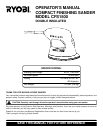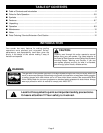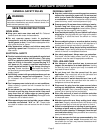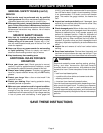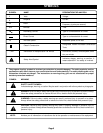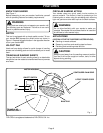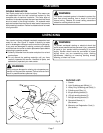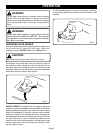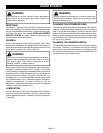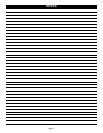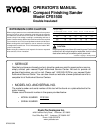
Page 10
WARNING:
When servicing use only identical Ryobi replacement
parts. Use of any other parts may create a hazard or
cause product damage.
IMPORTANT
Servicing of a tool with double insulation requires extreme
care and knowledge of the system and should be performed
only by a qualified service technician. For service we suggest
you return the tool to your nearest RYOBI AUTHORIZED
SERVICE CENTER for repair. When servicing use only
identical Ryobi replacement parts.
GENERAL
Avoid using solvents when cleaning plastic parts. Most
plastics are susceptible to damage from various types of
commercial solvents and may be damaged by their use. Use
clean cloths to remove dirt, carbon dust, etc.
WARNING:
Do not at any time let brake fluids, gasoline, petroleum-
based products, penetrating oils, etc. come in contact
with plastic parts. They contain chemicals that can
damage, weaken, or destroy plastic.
When electric tools are used on fiberglass boats, sports cars,
wallboard, spackling compounds, or plaster, it has been
found that they are subject to accelerated wear and possible
premature failure, as the fiberglass chips and grindings are
highly abrasive to bearings, brushes, commutators, etc.
Consequently, it is not recommended that this tool be used
for extended work on any fiberglass material, wallboard,
spackling compounds, or plaster. During any use on
fiberglass it is extremely important that the tool is cleaned
frequently by blowing with an air jet.
LUBRICATION
All of the bearings in this tool are lubricated with a sufficient
amount of high grade lubricant for the life of the unit under
normal operating conditions. Therefore, no further lubrication
is required.
MAINTENANCE
WARNING:
Always remove scrubbing pad or sanding sheet from
sander before cleaning. Failure to do so could cause
serious personal injury.
CLEANING THE SCRUBBING PADS
To ensure longer life and optimum performance, periodically
clean all residue and foreign materials from the scrubbing
pads. This can be done simply by rinsing the pad with warm
water untill all foreign material has been washed away. After
cleaning, gently squeeze the pad to remove excess water
and allow pad to dry. Always store pads and sanding sheets
flat in a cool dry location.
CLEANING THE SANDING SHEETS
The sanding sheets that came with your sander are made to
be re-used. Therefore, it is important that they be cleaned
periodically to remove sanding residue and foreign material
that can accumulate over time. To clean sanding sheets, rub
the sheets with a gum rubber block.



